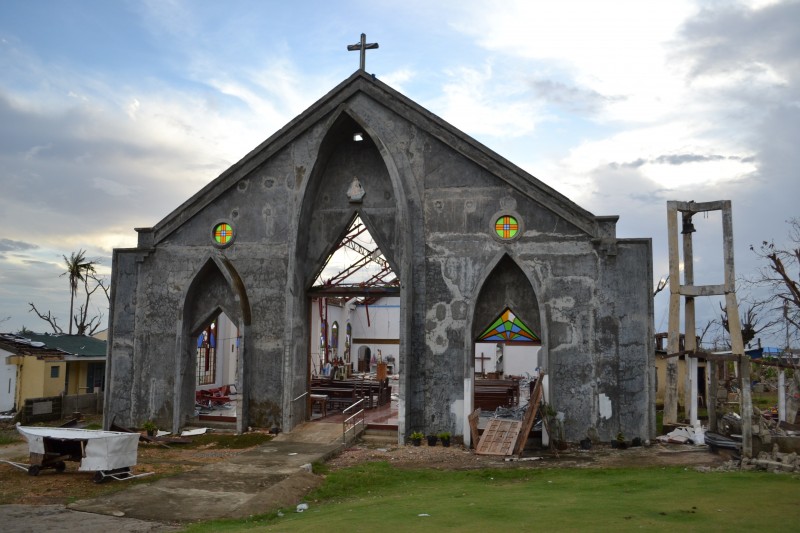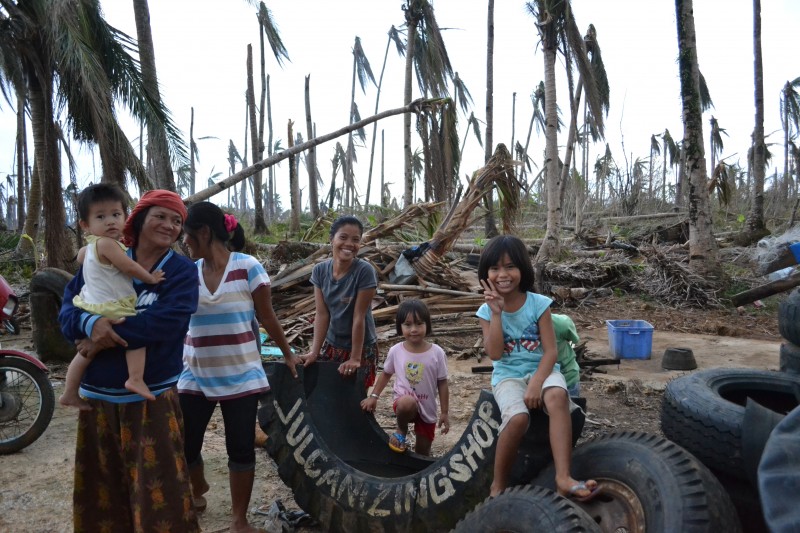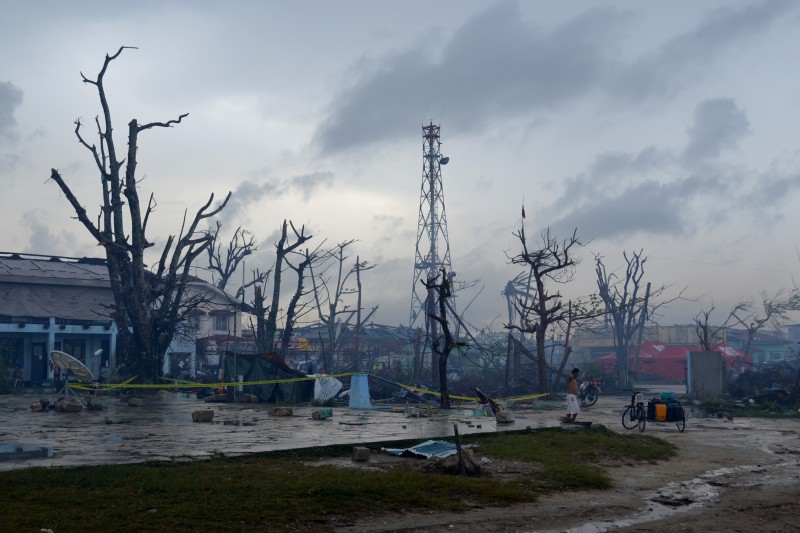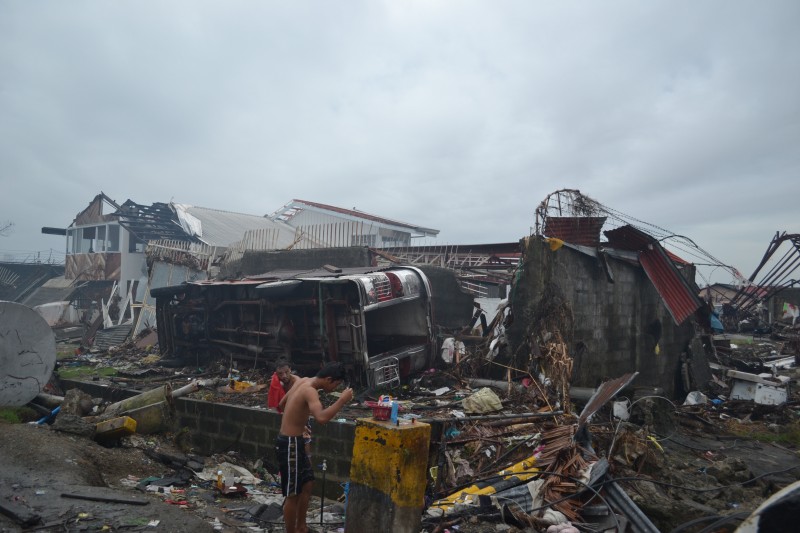Day 4: Forsaken land
The next day, the team interviewed some of the evacuees staying at the nearby school. They said tornado-like winds had ripped the roof off the two-storey building. Many structures they thought were safe crumbled under the terrifyingly strong winds.
Remedios Acal said they were staying at the town gym when Yolanda hit Guiuan. They could feel the walls shaking and swaying until finally they saw the roof being swept away. The exit was blocked by debris, and they thought they would be left there to die, but the locals worked together to free each one of them. Remedios was teary-eyed as she recalled how a young man, whom she has yet to find and thank, led the residents to safety.
READ: Guiuan folk: How shall we live?

Churches weren’t spared from the wrath of super typhoon Yolanda. PHOTOS BY KRISTINE SABILLO/INQUIRER.net
Many were injured by flying corrugated metal sheets and glass, her husband among them. Remedios said she was touched by the kindness of others, like the teacher who fed them lugaw (rice porridge) right after the typhoon, but she was worried about how they would survive without the help of good Samaritans and aid organizations.
Like many residents in Guiuan, Remedios’ husband is a fisherman who lost his boat during the typhoon.
Vice Mayor Rogel Cablao said he was worried too but also hopeful, saying the town has been faring relatively well when Guiuan’s airport became the operation and distribution center of relief goods in Eastern Samar. Outside the vice mayor’s office, soldiers came and went, bringing boxes of food and aid.
At Guiuan airport, US forces held almost complete control of the air strip, which had served as a US Navy air base during World War II. An aircraft marshal introduced the team to Logistics Officer John Duenas of the US Navy’s Expeditionary Strike Group 7.
By that time, Duenas said, the US military had already started pulling out of the region to let the Philippines “self-sustain.”
With many roads blocked by large trees and debris after the typhoon, US air assets were among the first to respond and reach far-flung areas.
Colonel Wilson Leyba, commander of Task Force Guiuan, confirmed that their US counterparts had started moving out as more relief trucks arrived from Manila.
READ: US forces start pullout from typhoon-hit areas in Eastern Samar

Typhoon survivors smile for the camera despite their houses being damaged. PHOTO BY KRISTINE SABILLO/INQUIRER.net
The team left Guiuan at around lunchtime.
It was definitely not part of our plan but we picked up a hitchhiker, a 69-year-old man in Salcedo, 16 kilometers away from Guiuan.
Mang Antonio was hoping to reach Tacloban, then Ormoc City, to catch a ferry to Davao where his other relatives lived.
We almost missed him, if not for a group of children who shouted and gestured at us to stop.
Picking up a hitchhiker seemed like a risk, but with no other vehicle in sight, the team decided to make room for another passenger.
Mang Antonio barely spoke Tagalog. Ryan, our videographer who understood a little of the local language, said Mang Antonio was staying with his son in Salcedo when the typhoon struck.
He used to live in Tanauan, Leyte (where at least a thousand people died from the storm surge). Mang Antonio and his family were lucky to be alive.
He ate the biscuits we gave him as we engaged in small talk.
For the most part of the two-hour drive to Western Samar, the weather was terrible. All we saw were toppled coconut trees along the 100-kilometer stretch of the road from Salcedo to Basey.
Thrice we passed by groups of children and even some adults begging for food. Some of them were holding signs, saying they needed as much help as those in Tacloban.
At Basey, we visited a church that served as the people’s sanctuary when the storm surges came. At least more than a dozen families remained in the church, using the pews as both their bed and dining table. Near the altar, a group of government doctors asked children to draw what they remember of the typhoon as part of their “play therapy.”
One doctor said they began to offer psycho-social support when they saw that people were complaining of bodily pains that didn’t go away despite taking painkillers. The pain, she said, was caused by stress and trauma. Drawing was supposed to help the children express their feelings, especially since they were the ones who felt most helpless during the calamity.
The doctor said many survivors remain terrified of the rain.
Outside the church, Mang Antonio was talking with local farmers who had their own stories to share. Many said they were tending to their farmlands when the typhoon struck, forcing them to cling to trees as the surge of water washed over their crops.
We reached San Juanico bridge by afternoon. (It was as beautiful as I remembered, but I couldn’t shake off the thought that dozens of bodies were found floating under it days after the storm.)
Less than an hour later we arrived in Tacloban. If Samar was the forsaken land, filled with barren hills and lifeless trees, Tacloban was a war zone. The coastal communities were reduced to rubble while cars were piled up along the streets.
The foul odor —of rotting corpses — pervaded the air.
We dropped Mang Antonio at the bus station and bid him goodbye.
















